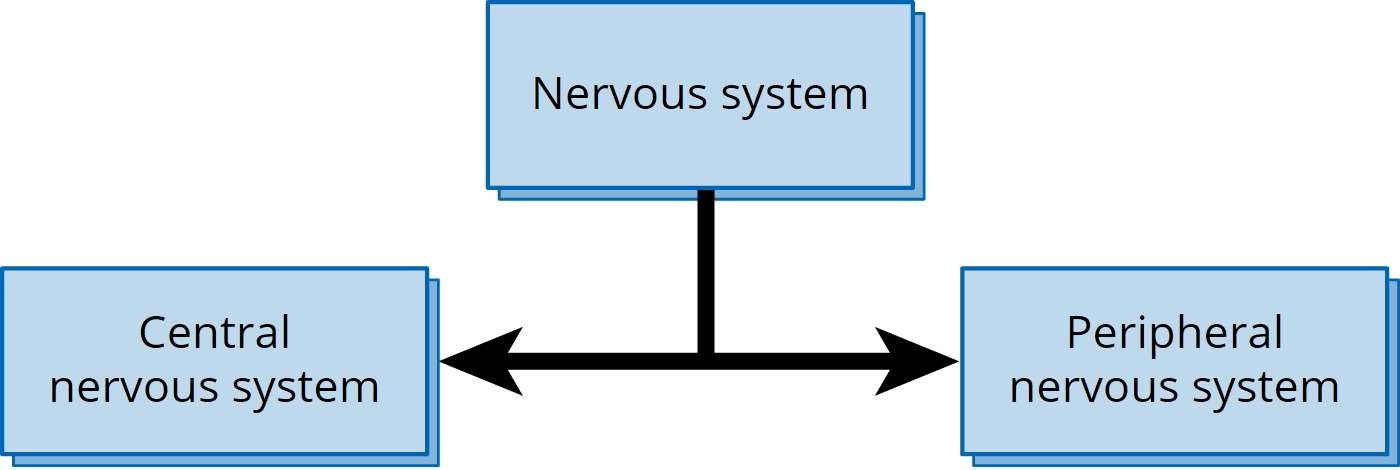Chapter 111. Divisions of the Nervous System
Learning Objectives
Describe the relationships among the divisions and subdivisions of the nervous system.
Identify the main functions of each portion of the nervous system.
Review
Review
Select the NEXT button to continue with the Review.
1. The nervous system is the human body’s fast communication system. It consists of the central nervous system (brain and spinal cord) and the peripheral nervous system (all the other nerves in the body). In all, the nervous system contains around 85 billion individual nerve cells called neurons.
Review
Review
Select the NEXT button to continue with the Review.

2. The central nervous system (often referred to as the CNS) includes most of the neurons in the body. It handles the information-processing and decision-making tasks. Sensory information from the outside world and from inside the body is channeled through the peripheral nervous system (PNS) and gets analyzed in the CNS. If some action is required, the CNS organizes a response and communicates the message through the peripheral nervous system to the appropriate muscles or internal organs.
Review
Review
Select the NEXT button to continue with the Review.
3. The peripheral nervous system is subdivided into the somatic nervous system (which carries sensory messages from skin and muscles, and controls the body’s movements) and the autonomic nervous system (which communicates with and regulates the internal organs, largely outside conscious awareness).
Review
Review
Select the NEXT button to continue with the Review.
4. The autonomic nervous system (sometimes referred to as the ANS) controls the glands and muscles of our internal organs. It regulates the automatic behaviors necessary for survival. (Autonomic means "self-regulating.") The autonomic nervous system has two subdivisions, one responsible for mobilizing us during stressful situations, and the other for calming us when the emergency has passed.
Review
Review
Select the NEXT button to continue with the Review.
5. The sympathetic division of the autonomic nervous system arouses the body during emergencies by accelerating heartbeat, slowing digestion, raising blood sugar, dilating arteries, and creating perspiration. This prepares the body for an energetic physical response to a threat or challenge, including the challenge of sexual intercourse.
Review
Review
Select the NEXT button to continue with the Review.
6. The parasympathetic division of the autonomic nervous system relaxes the body after the emergency has passed, by producing the opposite effects—slowing the heartbeat, stimulating digestion, lowering blood sugar, contracting the arteries, and shutting down perspiration. The parasympathetic system is also responsible for the localized sexual arousal of the genitals in both females and males. Although this connection to sexual arousal may seem an exception to the usual tendency of the parasympathetic division to calm the body, it makes sense in terms of survival—having engorged genitals would not be a useful response in the presence of danger, when the sympathetic division is activated.
Review
Review
Select the NEXT button to continue with the Review.
7. Here’s a memory aid—a sentence that may help you remember the general functions (except for sexual responses) of the two parts of the autonomic nervous system: The sympathetic division makes you sizzle (arouses you for action); the parasympathetic division pacifies you (calms you down).
Practice: Exploring the Nervous System
Practice: Exploring the Nervous System
Roll over each part of the nervous system to see a brief description.
nervous system
central nervous system (CNS)
brain
spinal cord
peripheral nervous system (PNS)
somatic nervous system
autonomic nervous system
sympathetic division
parasympathetic division
Description:
nervous system: the body’s fast communication system, consisting of billions of neurons; divided into the peripheral and central nervous systems
central nervous system (CNS): the spinal cord and the brain
brain: largest part of the central nervous system; consists of about 80 billion neurons organized into networks for processing sensory information, storing memories, and controlling behavior
spinal cord: the part of the central nervous system that extends downward from the brain through the spine
peripheral nervous system (PNS): the sensory and motor neurons outside the brain and spinal cord
somatic nervous system: the part of the peripheral nervous system that carries sensory information and controls body movements
autonomic nervous system: the part of the peripheral nervous system that regulates the internal organs
sympathetic division: the part of the autonomic nervous system that arouses the body for action
parasympathetic division: the part of the autonomic nervous system that calms the body after a stressful event has passed
Quiz 1
Quiz 1
Drag the label for each of the parts of the nervous system into the correct location on this chart. When all the labels have been placed, select the CHECK ANSWER button.
Quiz 2
Quiz 2
Match the parts of the nervous system with their descriptions by dragging each colored circle to the appropriate gray circle. When all the circles have been placed, select the CHECK ANSWER button.